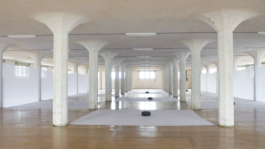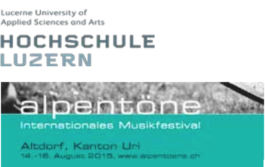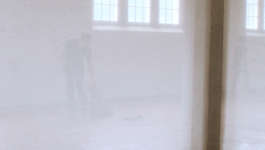
heiligtum sacklager
ca. 20 min., music performance/installation, 2015
The old portico, which used to serve as a warehouse for sacks of grain, is located on a disused freight depot. White nettle is stretched around the outermost rows of columns of the hall and thus divides the hall into an interior and an exterior space. In addition, the nettle spans in wide squares four columns each of the interior on the ground. Meditation cushions placed on it invite to linger. The sound level brings the historical significance of space back to the present. Their sound material consists of the things that were used to be part of the daily working: The sounds of bricks, sheet metal and grain sacks become a rhythmic web of noises of the former working day. Another sound material is the breath of the human voice. All few minutes, a freight train driving through the hall can be heard over loudspeakers, interrupting the auditory workflow. While the audience is on the floor inside the hall, the musicians* perform behind the veil nettle in the exterior space and are thus only visible as shadows behind the white fabric. The sound layer condenses into periodic sections until it culminates in an unbearably loud thunder of the sheet metal. What remains is a beat frequency caused by the superimposition played by adjacent quarter tones of two violins, which is supposed to give space to blend into the earlier to put the daily work routine in the sack warehouse into perspective.
credits:
concept, installation, rehearsals: Binha Haase / musicians: Carmen Bischof, Maude Cotton, Nick Furrer, Emilio Guim / Binha Haase, Nicole Näf, Silke Strahl, Christian Zemp
commissioned and produced by:
University of Applied Arts and Science Lucerne and
Alpentöne International Music Festival Altdorf


performance at Alpentöne International music festival, Altdorf, 2015